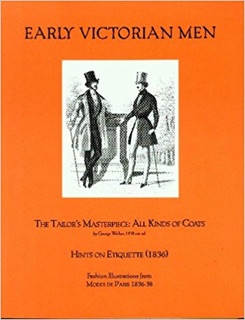We bought a copy of Early Victorian Men by R. L. Shep to help round out our menswear books at the workroom a while back.
 Amazon describes it as:
Amazon describes it as:
“The end of Men as Dandies & peacocks! Fashions did not change much since they were set by George IV and Beau Brummell except they were less extreme. This book is a good look at what they were between the 1820s up to 1850 and how to make them. After that they got more drab and less interesting. George Walker’s rare “The Tailor’s Masterpiece” of 1838 is paired with the full text of “Hints on Etiquette” 1836 and fashion plates from Modes de Paris to give a full picture of what was worn and when, what was proper and what was not. The manual features a wide range of all types of coats, capes, jackets, waistcoats, and uniforms.”
The general description is entirely correct, but there needs to be a caveat:
Get ready for some pre-Hemingway prose. For serious.
The language is that florid and multidirectional Victorian English that is both charming and tiresome. For someone who knows what they are doing, it is great; we don’t need to read as much of it. For the beginner? Well, we hope you were really good at diagramming sentences when you were in grade school, cause you will find clause buried in clause before you get to the meat of it.
For example, the first sentence:
“Instructions on the art of taking the dimensions of the human figure necessarily precede those on cutting, therefore on this head we commence and will clearly point out the real dimensions of every essential point necessary to be ascertained, in order to produce all of the parts of a garment correctly: and thus attain a certainty of measurement, instead of the ordinary, uncertain method, of depending on those deduced by the proportion of the breasts or other measures; or on problematical rules of any kind, in order to arrive at them.”
(1st page after introduction)
That, my friends, is a lot of windbaggery to say something more or less like:
“Instructions to take measurements have to come before instructions for cutting. In this book we will list all of the points one needs to produce a finished garment correctly using direct measurements instead of proportion charts or other measuring systems.”
Otherwise, good historical clothing reference. We use it up here to round out the menswear books and use it as a reference for costumers, guys who want a little goth in their lives, and the guy who wants something a little different.
So if you are new, prepare to wade through old prose a bit. It would be nice to have an edition cleaned up and annotated, but overall we’re VERY happy with it. A good addition for a workroom, costumer, or costume shop!